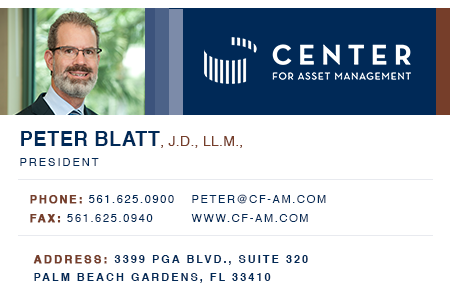By Peter Blatt, J.D., LL.M.
Early this morning as I was walking my golden retriever, Jack, I noticed the oddest of conversations. Some of my other dog walking neighbors, were upbeat and positive. One of my neighbors who is a real estate attorney, smiled as I walked by and said, ‘what a beautiful day.’ In fact, the weather for early May in South Florida is rather pleasant. My dog Jack attempted to say hello to her dog.
The next neighbor who I walked by was wearing a mask while walking her dog. She waited for my dog to pass her. She said to me, ‘I am concerned and need to stay at least 6 feet away from everyone.’ Medically, she might be correct. I do imagine it is hard to walk in the heat wearing an N95 mask. Jack also attempted to say hello to her dog.
As I came home and watched the latest jobless numbers and presentations by the Federal Reserve Chairman Powell, I thought about my walk. The real estate attorney neighbor is equivalent to some of the technology stocks in the market, showing signs of recovery and optimism about the future. The concerned neighbor is like the financial, energy, and retail sector, showing signs that the end of the fear is not near. The unemployment record is now at 14.7% in the United States.
A Brief History of the Unemployment Rate
Since 1901, the highest rate of U.S. unemployment was 24.9% in 1933, during the Great Depression. Unemployment remained above 14% from 1931 to 1940. It remained in the single digits until September 1982, when it reached 10.1%.
During the Great Recession of 2008 to 2009, unemployment reached 10% in October 2009. One of the two mandates of the Federal Reserve is to keep unemployment below 6%. The main method to increase employment by the Federal Reserve is to lower interest rates.
Now which of my neighbors are correct? We shall see but one thing I know, old strategies may not be true.
One of the oldest stock market strategies is to “Sell in May and Go Away.” But what does this phrase mean? Is there any historical reason for selling stocks in May and leaving the market? What are the risks? The Strategy “Sell in May and go away” is a well-known trading adage that recommends investors sell their stocks in May to avoid a seasonal decline in the stock market.
An investor selling his or her stocks in May would then buy stocks again in November because the November through April period shows significantly stronger growth in the market than the other half of the year.
However, this seasonal strategy flies in the face of the buy-and-hold strategy of investors like Warren Buffett, the wildly successful “Oracle of Omaha.”
History of the “Sell in May and go away” advice.
The advice originated in London, England. The original saying, “Sell in May and go away, come back on St. Leger’s Day” refers to a horse race. The St. Leger Stakes is one of England’s greatest horse races and is run in late September. London traders would sell their shares, enjoy their summer, and return to the market after the St. Leger race. The idea is based on seasonality and with this strategy, traders are only invested in the stock market for about six months of the year (November through April). These months are typically the strongest period of the stock market. Investors sell their stocks in May, save their money in cash, bonds, or another safe investment, then buy stocks again in early November. Statistics on this Strategy As it turns out, stocks have done better during the winter-early spring period. According to the Stock Trader’s Almanac, the Dow Jones Industrial Average has gained an average of about 7.5% during the November-April period since 1950. Its average return has been only 0.3% during the May-October period in those same years. In addition, the Dow Jones Industrial Average has lost money in only 14% of the November-April time periods since 1950. That success rate is remarkable.
However, looking at the S&P 500 from November 1, 2017 through April 30, 2018, the S&P 500 returned 2.33%. But if you sold out of equities in May 2017, only to get back in on November 1, 2017? Well you would have missed the S&P 500 returning 7.83%.
The stock market is showing signs of improvement since the big dip this past March 2020. The economy will improve as the fear of the virus subsides. Fear and superstition should not rule how to invest in the stock market.
It is going to get hotter in South Florida later in May. My walks will occur earlier in the morning. I will attempt to keep an open mind as I meet fearful neighbors. I am still upbeat about America and South Florida.
One of the big questions, that will be asked is how does the stock market effect the South Florida Real Estate Market? Sign up for our June 3rd Dine and Discover and find out.
Stay safe.
Plan Today. Protect Tomorrow.
Peter

©Copyright 2020 by Peter Blatt. All rights reserved.
Ready to Take The Next Step?
For more information about any of the products and services listed here, schedule a meeting today or register to attend a seminar.
